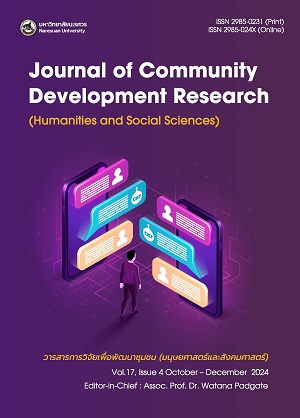Integrating Social Enterprise for Cultural Landscape Conservation: A Case Study of Koh Plubpla, Ratchaburi Province, Thailand
##plugins.themes.bootstrap3.article.main##
Abstract
This study focuses on exploring the dynamics of cultural change resulting from the transformation of agricultural land into commercial use through agritourism development. The concept of social enterprise is utilized as a core mechanism to manage community-centric landscape management and sustainably promote cultural landscape conservation. This qualitative research was conducted in Koh Plub Pla Subdistrict, Ratchaburi Province, with data collected from 60 primary informants and 12 key informants through in-depth interviews and focus group discussions. Additionally, three successful farm stay businesses in Ratchaburi Province were selected for interviews, based on criteria emphasizing compliance with agritourism quality standards established by the Department of Agricultural Extension.
The analysis applied the conceptual framework of “looking back to move forward”, integrating perspectives from contemporary vernacular architecture and sustainable development principles. The findings reveal that the social enterprise approach enhances integrated agriculture, generates economic benefits for local communities, and effectively conserves natural resources. However, project development in the study area faces complex challenges arising from local contexts. Adapting to socio-economic conditions and policy frameworks is essential for sustainable project planning. Strengthening collaboration among stakeholders, building community capacity, and addressing environmental factors are key to achieving smooth development aligned with both vertical and horizontal dimensions of the local context.
Furthermore, this study proposes a novel approach emphasizing the integration of social enterprise with cultural landscape management that prioritizes community participation. This integration aims to ensure appropriate land use and foster sustainable economic growth in the future.
Keywords: Social Enterprise, Community-Centric Landscape Management, Sustainable Development, Cultural Landscape Conservation, Community Participation
References
Bramwell, B., & Sharman, A. (1999). Collaboration in Local Tourism Policymaking. Annals of Tourism Research, 26(2), 392-415. https://doi.org/10.1016/S0160-7383(98)00105-4
Castells, M. (2009). The Rise of the Network Society (2nd ed.). USA.: Wiley-Blackwell. https://doi.org/10.1002/9781444319514
Cumming, G. S., Olsson, P., Chapin III, F. S., & Holling, C. S. (2013). Resilience, Experimentation, and Scale Mismatches in Social-ecological Landscapes. Landscape Ecology, 28(6), 1139-1150. https://doi.org/10.1007/s10980-012-9725-4
Duxbury, N., & Jeannotte, M. S. (2010). Culture, Sustainability, and Communities: Exploring the Myths. In 6th International Conference on Cultural Policy Research, Jyväskylä, Finland, August 24-27, 2010 (pp 1-25). Finland: University of Jyväskylä.
Global Tomorrow Coalition. (1990). The Global Ecology Handbook: What You Can Do about the Environmental Crisis. Boston: Beacon Press.
Huang, L., Xiang, W., Wu, J., Traxler, C., & Huang, J. (2019). Integrating GeoDesign with Landscape Sustainability Science. Sustainability, 11(3), 833. https://doi.org/10.3390/su11030833
Hunt, J. D. (1992). Gardens and the Picturesque: Studies in the History of Landscape Architecture. Cambridge, MA: MIT Press.
Mair, J., & Martí, I. (2004). Social Entrepreneurship Research: A Source of Explanation, Prediction, and Delight. Journal of World Business, 41(1), 36-44. https://doi.org/10.1016/j.jwb.2005.09.002
Marcus, C. C., & Francis, C. (1998). People Places: Design Guidlines for Urban Open Space (2nd ed.). New York: John Wiley & Sons.
OECD. (2006). The New Rural Paradigm: Policies and Governance. France: OECD Publishing. https://doi.org/10.1787/9789264023918-en
Office of Land Development Region 10. (2021). Land Use Planning of Koh Plub Pla Subdistrict, Mueang District, Ratchaburi Province. Bangkok: Department of Land Development, Ministry of Agriculture and Cooperatives. Retrieved from https://webapp.ldd.go.th/lpd/Maps_2_RBR.php
Office of the National Economic and Social Development Board, Office of the Prime Minister. (2017). The Twelfth National Economic and Social Development Plan (2017-2021). Bangkok, Thailand: Office of the Prime Minister. Retrieved from https://www.nesdc.go.th/nesdb_en/ewt_dl_link.php?nid=4345
Reed, M. S. (2008). Stakeholder Participation for Environmental Management: A Literature Review. Biological Conservation, 141(10), 2417-2431. https://doi.org/10.1016/j.biocon.2008.07.014
Sawasdee, W., & Masae, A. (2020). Potentiality Development of Tourism Social Enterprises in Thailand. Journal of Social Development and Management Strategy, 22(2), 1–22. Retrieved from https://so04.tci-thaijo.org/index.php/jsd/article/view/249231
Schama, S. (1995). Landscape and Memory. New York: Alfred A. Knopf.
Selman, P. (2004). Community Participation in the Planning and Management of Cultural Landscapes. Journal of Environmental Planning and Management, 47(3), 365-392. https://doi.org/10.1080/0964056042000216519
Slaper, T. F., & Hall, T. J. (2011). The Triple Bottom Line: What Is It and How Does It Work? Indiana Business Review, 86(1), 4-8. Retrieved from https://www.ibrc.indiana.edu/ibr/2011/spring/article2.html
Thompson, I. H. (2014). Landscape Architecture: A Very Short Introduction. Oxford: Oxford University Press.
Wates, N. (2000). The Community Planning Handbook: How People Can Shape Their Cities, Towns and Villages in Any Part of the World. London: Earthscan Publications.
